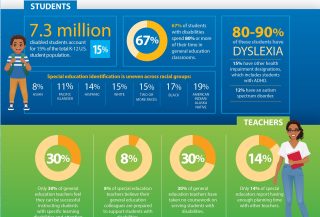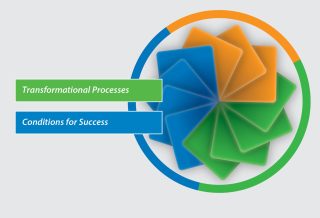NETWORKS AT WORK
IC maps bring clarity to complex change projects
By Michelle Bowman
Categories: Continuous improvement, Standards for Professional LearningApril 2023
It can be challenging to translate a vision of school improvement into daily practice, especially when multiple schools or systems are working together to achieve change at scale. To help address this challenge, the hub team of the Texas Network for School Improvement (TxNSI) created a set of Innovation Configuration (IC) maps (Hall & Hord, 2010; Hord et al., 2006), a resource to describe what continuous improvement looks like when enacted in systems and schools. These maps provide clear descriptions of what it looks like when schools operate as a successful, improvement-focused network.
IC maps describe what an innovation’s major components look like in practice and how users vary these components while implementing them. They are deliberately multifunctional; they can guide planning, implementation, monitoring, evaluation, and more.

Learning Forward has used IC maps for many years, primarily to support understanding and implementation of Standards for Professional Learning (Learning Forward, 2022), and we have found that they provide much-appreciated clarity and direction for complex change efforts. They can be a valuable resource for networks like TxNSI, as well as for other systems seeking to improve practice.
What do Innovation Configuration (IC) maps look like? They ''provide clear descriptions of what it looks like when schools operate as a successful, improvement-focused network.'' #TheLearningPro Share on XAbout TxNSI
The Texas Network for School Improvement (TxNSI) Collaborative is a networked improvement community supported by the Bill & Melinda Gates Foundation. The network’s
goal is to increase the percentage of Black and Latino students and students experiencing poverty who are on track to college and career success by the end of 8th grade, using math as the entry point. TxNSI uses a set of braided supports: tailored professional learning, coaching to support campus teams, professional learning communities, support for testing change ideas to address specific challenges, and a facilitated network approach to learn from one another.
The network spans districts in Texas Education Service Center Regions 10 and 11. Participating district and campus teams define a local aim within the context of the overall network aim before selecting a specific change idea to implement through the use of a rapid-cycle continuous improvement framework.
Three organizations form the hub team that supports schools. Educate Texas serves as the network lead, identifying schools, coordinating operations and communications, and analyzing network-level data. Learning Forward focuses on professional learning for network educators, emphasizing continuous improvement methods. The Dana Center provides expertise in mathematics instruction and research.
As part of that hub, Learning Forward led the writing process for the TxNSI IC maps, with review and input from the other TxNSI hub team members, Educate Texas and the Dana Center. We then designated district leaders from Crowley ISD and Richardson ISD to review the maps aligned with their specific role (e.g., coach or principal), reflect on where they found themselves on the spectrum of implementation, and offer feedback. One district leader said that the language helped her to recenter on the expectations for continuous improvement.
About the IC maps
The TxNSI IC maps help clarify the roles and attributes of the network, foster dialogue about best practices, and provide direction for professional learning and network implementation. The intentional structure of an IC map communicates the major principles or key ideas, main components, and desired outcomes of the innovation. Each desired outcome has a continuum of behaviors for each designated role. The most desirable or ideal behavior is in the column on the left. The column on the right describes an entry-level behavior. By design, IC maps acknowledge differences in system contexts, structures, needs, and resources and allow for flexibility and creativity in reaching the desired outcomes.
The TxNSI IC maps are informed by Standards for Professional Learning and are a valuable tool for ensuring that improvement efforts align with the standards. For example, by making explicit the continuum of behaviors educators might progress through to strengthen implementation of the innovation over time, the IC maps reinforce the Implementation standard.
IC maps also help educators deepen their Professional Expertise. They show the variations across and among educator roles so educators can strategize and plan at the school or system level, attending to coherence and alignment across roles and balancing individual and collective learning needs. They also help learning designers build on educators’ prior knowledge, experiences, and strengths, and “spread expertise among team members” and “leverage complementary expertise efficiently to accomplish shared goals” (Learning Forward, 2022, p. 30).
In addition, the IC maps encourage individuals and school teams to check progress and examine data, which enacts the Evidence standard and helps educators monitor, assess, and plan for future professional learning.
TxNSI IC maps in practice
At the beginning of the 2022-23 school year, facilitators from the network schools and systems used the IC map for their role to reflect on their behaviors, where they would like to improve, and what support they need to continue working toward the ideal state. The hub team examined the self-report data and used the responses to help frame one-on-one coaching and group learning. Additionally, school and district leaders reflected after a midyear network convening. Their responses will help us design professional learning with an eye toward sustainability.
We see great value in this process, and we encourage educators from other systems to consider how they can use IC maps and related tools for intentional improvement. You can access the full TxNSI IC maps on our website at learningforward.org/networks/#TXNSI. Learn more about the Texas Network for School Improvement (TxNSI) at txnsi.org.
Download pdf here.
IC maps describe what an innovation’s major components look like in practice and how users vary these components while implementing them.
References
Hall, G. & Hord, S. (2010). Implementing change: Patterns, principles, and potholes (3rd ed.). Prentice Hall.
Hord, S., Rutherford, W., Huling-Austin, L., & Hall, G. (2006). Taking charge of change. SEDL.
Learning Forward. (2022). Standards for Professional Learning. Author.

Michelle A. Bowman is senior vice president of networks and continuous improvement at Learning Forward. She engages in and executes cross-organizational strategic thinking, especially through the strategy of networks and communities of practice, that supports state and local education agencies committed to professional development redesign. She also oversees the development of content and learning designs that support organizations' capacity to engage in continuous improvement processes. With 30 years in public education, Michelle served in leadership at the district, campus, and classroom levels before joining Learning Forward. Michelle has an Ed.D. in Learning and Organizational Change from Baylor University. Her dissertation investigated how school district leaders engaging in a community of practice impacts their professional learning efficacy. She also co-authored Teacher Professional Development in the Digital Age: Design and Implementation of Learning without Limits in Technology in the Classroom: How It Can Improve Teaching and Student Learning in American Schools (Rowman & Littlefield, 2017) with Learning Forward Executive Director (retired) Stephanie Hirsh. Michelle refreshes her soul, mind, and body by singing songs of worship and spending time with family and friends. She enjoys great coffee and long walks.
Categories: Continuous improvement, Standards for Professional Learning
Recent Issues
LEARNING DESIGNS
February 2025
How we learn influences what we learn. This issue shares essential...
BUILDING BRIDGES
December 2024
Students benefit when educators bridge the continuum of professional...
CURRICULUM-BASED PROFESSIONAL LEARNING
October 2024
High-quality curriculum requires skilled educators to put it into...
LEARNING TO PIVOT
August 2024
Sometimes new information and situations call for major change. This issue...












